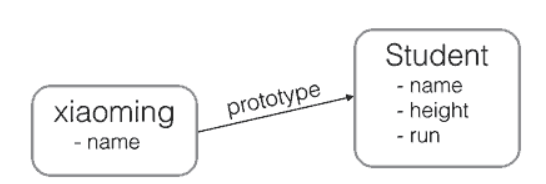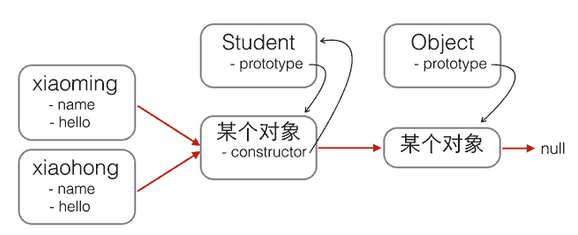1.面向对象编程
javscript不区分类和实例的概念,而是通过原型(prototype)来实现面向对象编程。
var Student = {
name: 'Robot',
height: 1.2,
run: function () {
console.log(this.name + ' is running...');
}
};
var xiaoming = {
name: '小明'
};
xiaoming.__proto__ = Student;注意最后一行代码把xiaoming的原型指向了对象Student,看上去xiaoming仿佛是从Student继承下来的:
xiaoming.name; // '小明'
xiaoming.run(); // 小明 is running...xiaoming有自己的name属性,但是并没有定义run()方法。不过由于小明是从student继承而来的,只要Student有run()方法,xiaoming也可以调用。

所谓的继承关系不过是把一个对象的原型指向另一个对象而已。
创建原型继承:
/ 原型对象:
var Student = {
name: 'Robot',
height: 1.2,
run: function () {
console.log(this.name + ' is running...');
}
};
function createStudent(name) {
// 基于Student原型创建一个新对象:
var s = Object.create(Student);
// 初始化新对象:
s.name = name;
return s;
}
var xiaoming = createStudent('小明');
xiaoming.run(); // 小明 is running...
xiaoming.__proto__ === Student; // true2.创建对象
JavaScript对每个创建的对象都会设置一个原型,指向它的原型对象。
当使用obj.**访问一个对象的属性时,javascript先在当前对象上查找该属性,如果没有找到,就到其原型对象上找,如果还没有找到,就一直上溯到Object.prototype对象,最后,如果还没有找到,就只能返回undefined。
例如:创建一个Array对象
var arr=[1,2,3];其原型链是:
arr---->Array.prototype---->Object.prototype------>nullArray.prototype定义了indexof(),shift()等方法,因此你可以在所有的Array对象上直接调用这些方法。
function foo(){
return 0;
}函数也是一个对象,它的原型链是:
foo----->Function.prototype----->Object.prototype----->null由于Function.prototype定义了apply()等方法,因此,所有函数都可以调用apply()方法。
构造函数
除了直接用{ }创建一个对象外,javascript还可以用一种构造函数的方法来创建对象。它的用法是,先定义一个构造函数。
function Student(name){
this.name=name;
this.hello=function (){
alert('hello'+this.name+'!');
}
}这是一个普通的函数,但是在javascript中,可以用关键字new来调用这个函数,并返回一个对象
var xiaoming=new Student('小明');
xiaoming.name; //小明
xiaoming.hello();// hello 小明注意:如果不写new,这就是一个普通函数,它返回undefined。但是,如果写了new,它就变成了一个构造函数,它绑定的this指向新创建的对象,并默认返回this。也就是说,不需要在最后写return this;
新创建的xiaoming的原型链是:
xiaoming--->Student.prototype--->Object.prototype---->null用new Student()创建的对象还从原型上获得了一个constructor属性,它指向函数Student本身:
xiaoming.constructor === Student.prototype.constructor; // true
Student.prototype.constructor === Student; // true
Object.getPrototypeOf(xiaoming) === Student.prototype; // true
xiaoming instanceof Student; // true红色箭头是原型链。注意,Student.prototype指向的对象就是xiaoming、xiaohong的原型对象,这个原型对象自己还有个属性constructor,指向Student函数本身。
函数Student恰好有个属性prototype指向xiaoming、xiaohong的原型对象,但是xiaoming、xiaohong这些对象可没有prototype这个属性,不过可以用__proto__这个非标准用法来查看。xiaoming.hello; // function: Student.hello()
xiaohong.hello; // function: Student.hello()
xiaoming.hello === xiaohong.hello; // falsexiaoming和xiaohong各自的hello是一个函数,但它们是两个不同的函数,虽然函数名称和代码都是相同的!
如果通过new Student()创建了很多对象,这些对象的hello函数实际上只需要共享同一个函数就可以了,这样可以节省很多内存。要让对象共享一个hello函数,根据对象的属性查找原则,只要把hello函数移动到共同的原型上就可以了,也就是Student.prototype:
function Student(name) {
this.name = name;
}
Student.prototype.hello = function () {
alert('Hello, ' + this.name + '!');
};注意:
如果一个函数被定义为创建对象的构造函数,但是调用时忘记了写new。
**在严格模式下,**this.name=name将报错,因为this绑定为undefined。
在非严格模式下,不报错,因为this绑定了window,于是创建了全局变量name,并且返回undefined,这个结果更糟糕。
构造函数的首字母应该大写,而普通函数的首字母小写。
3 原型继承
现在要基于Student扩展出PrimaryStudent,可以先定义出PrimaryStudent
function PrimaryStudent(props){
//调用Student构造函数,绑定this变量
Student.call(this,props);
this.grade=props.grade|| 1;
}但是调用了Student构造函数不等于继承了Student,PrimaryStudent创建的对象原型是:
new PrimaryStudent() ----> PrimaryStudent.prototype ----> Object.prototype ----> null
必须想办法把原型链修改为:
new PrimaryStudent() ----> PrimaryStudent.prototype ----> Student.prototype ----> Object.prototype ----> null
这样,原型链对了,继承关系就对了。新的基于PrimaryStudent创建的对象不但能调用PrimaryStudent.prototype定义的方法,也可以调用Student.prototype定义的方法。
这时,可以借助一个中间对象来实现正确的原型链,这个中间对象的原型要指向Student.prototype。中间对象可以用一个空函数F来实现。
// PrimaryStudent构造函数:
function PrimaryStudent(props) {
Student.call(this, props);
this.grade = props.grade || 1;
}
// 空函数F:
function F() {
}
// 把F的原型指向Student.prototype:
F.prototype = Student.prototype;
// 把PrimaryStudent的原型指向一个新的F对象,F对象的原型正好指向Student.prototype:
PrimaryStudent.prototype = new F();
// 把PrimaryStudent原型的构造函数修复为PrimaryStudent:
PrimaryStudent.prototype.constructor = PrimaryStudent;
// 继续在PrimaryStudent原型(就是new F()对象)上定义方法:
PrimaryStudent.prototype.getGrade = function () {
return this.grade;
};
// 创建xiaoming:
var xiaoming = new PrimaryStudent({
name: '小明',
grade: 2
});
xiaoming.name; // '小明'
xiaoming.grade; // 2
// 验证原型:
xiaoming.__proto__ === PrimaryStudent.prototype; // true
xiaoming.__proto__.__proto__ === Student.prototype; // true
// 验证继承关系:
xiaoming instanceof PrimaryStudent; // true
xiaoming instanceof Student; // true
如果把继承这个动作用一个inherits()函数封装起来,还可以隐藏F的定义,并简化代码:
function inherits(Child, Parent) {
var F = function () {};
F.prototype = Parent.prototype;
Child.prototype = new F();
Child.prototype.constructor = Child;
}function Student(props) {
this.name = props.name || 'Unnamed';
}
Student.prototype.hello = function () {
alert('Hello, ' + this.name + '!');
}
function PrimaryStudent(props) {
Student.call(this, props);
this.grade = props.grade || 1;
}
// 实现原型继承链:
inherits(PrimaryStudent, Student);
// 绑定其他方法到PrimaryStudent原型:
PrimaryStudent.prototype.getGrade = function () {
return this.grade;
};javascript的原型继承实现方式就是:
1.定义新的构造函数,并在内部用call()调用希望继承的构造函数,并绑定this
2.借助中间函数F实现原型链继承,最好通过封装的inherits函数完成
3.继续在新的构造函数的原型上定义新方法
4 class继承
新的关键字class从ES6开始正式被引入到JavaScript中。class的目的就是让定义类更简单。
class Student{
constructor(name){
this.name=name;
}
hello(){
alert('hello, '+this.name+'!');
}
}比较一下就可以发现,class的定义包含了构造函数constructor和定义在原型对象上的函数hello().
创建一个Student对象代码和前面章节完全一样
var xiaoming=new Student('小明');
xiaoming.hello();通过class定义对象的更方便继承,直接通过extends来实现:
class PrimaryStudent extends Student {
constructor(name, grade) {
super(name); // 记得用super调用父类的构造方法!
this.grade = grade;
}
myGrade() {
alert('I am at grade ' + this.grade);
}
}注意PrimaryStudent的定义也是class关键字实现的,而extends则表示原型链对象来自Student。子类的构造函数可能会与父类不太相同,例如,PrimaryStudent需要name和grade两个参数,并且需要通过super(name)来调用父类的构造函数。
PrimaryStudent已经自动获得了父类Student的hello方法,我们又在子类中定义了新的myGrade方法。























 545
545











 被折叠的 条评论
为什么被折叠?
被折叠的 条评论
为什么被折叠?








